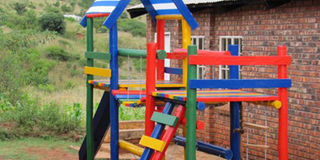Creating a play area at home

This is a classic play tower for children as it involves climbing and sliding elements that keep hyperactive children busy. One thing you should consider while constructing one is a shock absorbing ground cover such as grass or sponge and use plastic materials to avoid injuries and body harm. Interviews and photos by Dominic Bukenya
What you need to know:
Children do not always have to be taken to hangouts to enjoy and have fun. Today Roland Derrick Nasasira brings you do-it-yourself tips on how to keep the little ones busy at home.
Children love fun. Children are energetic. And, children love to play. No wonder work without play makes them dull.
So, in an African setting, a play area is a gazetted area where children either at home or at school in an early education setting, particularly pre-primary school, retire to, during break time or at any time of the day provided it is part of the school or home programme. Creating a play area is not simple because of reasons like insufficient funds or limited space outside the house.
The seesaw
Remember when you sat on the logs or pieces of timber chanting away.. “Seesaw concoction, mother in the kitchen, cooking chapatti, I wonder what you got in Mathematics…” on and on, the song went. This was because the seesaw felt good as the small bodies enjoyed swinging on a weighing scale. So this fun should not die out as recreational centres and children’s parks have taken over.
Annet Namulondo, a nursery teacher at Ebenezer Nursery and Primary School in Kisugu, a Kampala suburb, says a sophisticated play area has got to have lake sand to maintain cleanliness of children while playing.
“This sand is also good in such a way that in case the children are tired of swinging and climbing up and down, small tins can be introduced on the same area without changing locations as children enjoy measuring sand in tins by way of competing,” she says.
What to consider
David Senkubuge, a welder at Lusse Metal Workshop in Katwe, a Kampala suburb, says children’s swings in play areas such as the merry-go-round swing, chain swing and sliding boat should be placed in an area with sand because in the process of children climbing up the swing and they accidentally fall, they are not severely injured.
“When grass is planted in a play area, it does not only cause bruises on body parts like knees and elbows when the children fall from different positions and also disappear with time, but it also dirties them unlike sand which can just be easily wiped off,” Senkubuge says.
While children are playing on high swings, an adult should watch over them to avoid severe injuries or getting stuck in-between the swings. Namulondo says, a play area has to be spacious enough for children to move and also give room for simple toys and resources to encourage movement and keep children physically active.
“Parents need to think beyond running and include playing equipment to encourage hopping, jumping, skipping, sliding, swinging, rolling, balancing and throwing,” Namulondo says.
She adds, “there are those that might be more permanent like a slide, jungle gym or trampoline, simple homemade toys like a box car, or utilise loose equipment such as hoopla hoops, skipping ropes, balls and bikes.”
“If at all one has the finances, they can buy a bouncy castle and place it in a compound where the children can always go to in their free time. It has to be of an average size fit enough to be contained in the available space,” says Amanda Asiimwe, a parent.
When there is a compound with grass at home, it can as well act as a play area for children instead of straining hard to buy expensive equipment.
Interviews and photos by Dominic Bukenya




